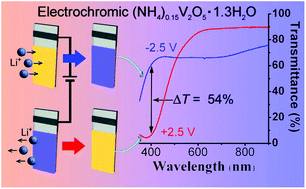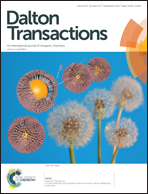Influence of vanadium concentration and temperature on the preparation of electrochromic thin films of ammonium intercalated vanadium(v) oxide xerogel nanoribbons
Abstract
A new and simple chemical method for deposition of thin films of ammonium intercalated V2O5·nH2O xerogels has been designed. The chemical deposition has been performed in aqueous solutions of ammonium metavanadate and acetic acid at temperatures between 50 and 85 °C. Depending on the vanadium concentration and deposition temperature xerogels with different composition have been prepared. The structure, morphology, electrochemical and electrochromic behaviour of the thin films with a composition of (NH4)0.15V2O5·1.3H2O have been examined. The film morphology comprises randomly oriented ribbon-like units (100 nm wide and about 500 nm long) which are composed of aggregated primary smaller particles in the nanoscale region of 50–100 nm. Two relatively stable redox pairs are observed in the cyclic voltammograms which correspond to the two-step electrochromism with colour transformations yellow/green and green/blue. The thin film thickness is found to have strong influence on the transmittance variance as deduced by the optical spectra of the reduced and oxidized states. The best result regarding the transmittance variance of 54% at 400 nm is achieved with thin films with thickness of about 200 nm which makes the prepared films very attractive for application in electrochromic devices.


 Please wait while we load your content...
Please wait while we load your content...